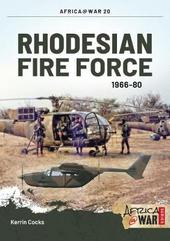
|
Rhodesian Fire Force 1966-80
Paperback
Main Details
| Title |
Rhodesian Fire Force 1966-80
|
| Authors and Contributors |
By (author) Kerrin Cocks
|
| Series | Africa@War |
|---|
| Physical Properties |
| Format:Paperback | | Pages:72 | | Dimensions(mm): Height 297,Width 210 |
|
| Category/Genre | African history |
|---|
| ISBN/Barcode |
9781910294055
|
| Classifications | Dewey:968.9104 |
|---|
| Audience | | Professional & Vocational | |
|---|
| Illustrations |
c 150 colour & b/w photos, maps maps
|
|
Publishing Details |
| Publisher |
Helion & Company
|
| Imprint |
Helion & Company
|
| Publication Date |
15 October 2014 |
| Publication Country |
United Kingdom
|
Description
On 11 November 1965, Rhodesian prime minister Ian Smith unilaterally declared his country independent of Britain. International sanctions were immediately instituted against the minority white regime as Robert Mugabe's ZANLA and Joshua Nkomo's ZIPRA armies commenced their armed struggle, the Chimurenga, the war of liberation. As Communist-trained guerrillas flooded the country, the beleaguered Rhodesians, hard-pressed for manpower and military resources, were forced to devise new and innovative methods to combat the insurgency. Fire Force was their answer. Fire Force as a military concept dates from 1974 when the Rhodesian Air Force (RhAF) acquired the French MG151 20mm cannon from the Portuguese. Visionary RhAF and Rhodesian Light Infantry (RLI) officers expanded on the idea of a 'vertical envelopment' of the enemy, with the 20mm cannon being the principal weapon of attack, mounted in an Alouette III K-Car ('Killer car'), supported by ground troops deployed from G-Cars (Alouette III troop-carrying gunships and latterly Bell 'Hueys') and parachuted from DC-3 Dakotas. In support would be a propeller-driven ground-attack aircraft armed with front guns, pods of napalm, white phosphorus rockets and a variety of Rhodesian-designed bombs; on call would be Canberra bombers, Hawker Hunter and Vampire jets. In spite of the overwhelming number of enemy pitted against them, Rhodesian Fire Forces accounted for thousands of enemy guerrillas, with a kill ratio exceeding 80:1. At the end of the war, ZANLA generals admitted their army could not have survived another year in the field-in no small part due to the ruthless efficiency of the Fire Forces, described by Charles D. Melson, the Chief Historian of the U.S. Marine Corps, as the ultimate""killing machine"".
Author Biography
Kerrin Cocks, a journalist by profession, has worked in the military-history publishing industry for fourteen years. She conceptualized the Africa@War series (co-published by 30 South and Helion & Co.) In 2009 she scripted, directed, produced and edited the full-length DVD documentary that accompanied Richard Wood's book Counter-Strike from the Sky: The Rhodesian All-arms Fireforce in the War in the Bush, 1974-1980, which was bought and aired on the New Zealand Documentary Channel. She is the author of Rhodesian Fire Force, 1966-1980 (2015) and co-author of I Won't be Home Next Summer: Flight Lieutenant R.N. Selley DFC (1917-1941) (2014). She lives in Barberton, South Africa.
|